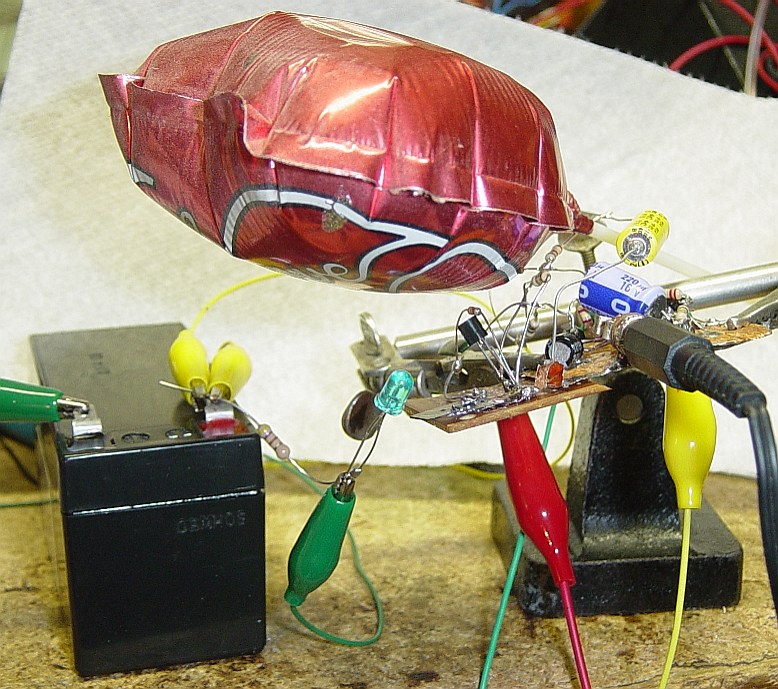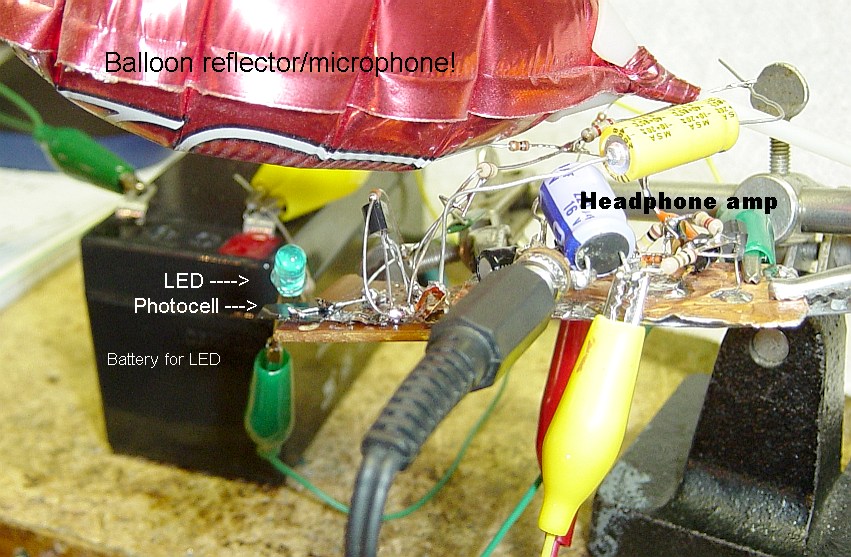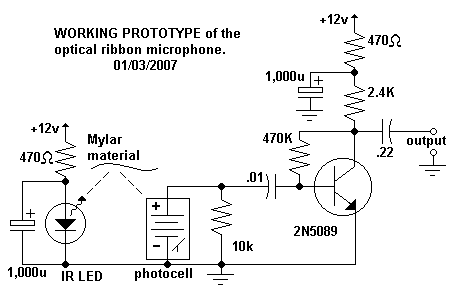
God Bless America!
N1NKM's

INSANE BTN page 2 |
INSANE!!!
"BTN!" 2
|
This was my WORKING,
HOT AIR Microphone! ;)
| Talk about INSANE BTN, this is it! |
 |
Hard to believe, but THIS THING was a WORKING MICROPHONE!!
Don't believe me? Here's a recording of me transmitting with it, made by a guy in NH!
N1NKMballoon.mp3
| It's a BALLOON used as a microphone!! |
 |
Here's a labeled version, to help point out what's happening here. :) In this lashup, the LED is powered by a battery, to ensure an absolutely PURE DC light source. The LED's light reflects off of the mylar balloon, and hits the small photocell. Because the balloon vibrates when you speak close to it, those vibrations cause the reflected light to vary, thus creating a varying voltage in the photocell. A single transistor preamp boosts the output enough to drive the input to the transmitter, and presto! It's on the air, baby! :) I tested it, and sure enough, it works! It has a very "hollow" sound to it, naturally, but this proves that the concept of using an LED and a photocell as a microphone pickup WILL WORK! Any reflective surface that is attached to some kind of diaphragm will work. Mylar balloons are great, because they are VERY thin, and usually very reflective. As long as it's very reflective, a candy wrapper, potato chip bag, etc, could also be used.
Yes, I KNOW that spies have done similar things with lasers off windows... but this is different! :) This is something ANYONE can do with virtually NO expense! You're NOT looking at the phase of light (egads, what kind of equipment do you need for THAT, anyway?!?!) you're simply looking for amplitude variations from the reflective mylar surface. Nice & simple. :) (Of course, it needs to operate in the dark!) To use the "hot air mic" I have to turn the AC-powered lights off, and use a DC-powered LED light to see.
Credit where credit is due... I was talking to Stu, again (AB2EZ) on 1/2/07, and he discussed an idea of bouncing a laser beam off a reflective surface to use as a microphone. Yup, you guessed it... I WAS INSPIRED, AGAIN!!! These are the results! Thanks, Stu! ;)
My 'encore? Good question... I tried adapting this technology into a new "ribbon mic", using a MYLAR ribbon to reflect light. (No magnets, no transformer, no hum pickup!) This could turn out to be a pretty decent-sounding microphone, too. Of course, it will need to be inside a light-tight enclosure. I already have tested the mylar ribbon, and it works! I tried building the new photocell/preamp detector module. It works fine, but the "mic enclosure" I used was not very successful. I eventually gave up tinkering with it, due to more pressing matters. BUT, that doesn't mean the idea is no good! Just that I struggled to get it working. The balloon was actually quite effective!
| Optical (balloon) mic schematic |
 |
Here's the WORKING schematic! This is not likely to change. The LED and the photocell/preamp are on separate mini modules. The physical arrangement of these modules and the mylar material are will need to be experimented-with for optimal performance. The LED requires its own resistor and bypass cap, to ensure that it sees only pure DC.
Basically, I am now finished with the balloon mic. It served its purpose. :)
Development of an OPTICAL RIBBON MIC followed!
What is "BTN"? Click here.
RETURN TO HOME PAGE




